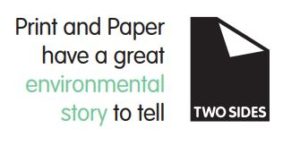The pulp, paper and print industry is relatively energy intensive, at 3.1% of European energy consumption. However, it also has a proven commitment to energy efficiency and is Europe’s biggest industrial user of renewable energy.
The sector is responsible for comparatively low greenhouse gas emissions, at only 0.6% of the European total. The paper industry’s key raw material, wood fibre, also sequesters greenhouse gases from the atmosphere and this benefit continues for the duration of the fibre’s life cycle. Furthermore, the industry is committed to clear and credible carbon footprint calculations so that stakeholders can have trust in the information they receive.

Pulp and paper is a substantial industrial user of energy but has a proven commitment to energy efficiency, including the widespread investment in Combined Heat and Power systems.
Around a quarter of Europe’s energy consumption is by industry (about another quarter is residential and around a third is for transport). Pulp, paper and print account for 3.1% of total energy consumption, below that for iron and steel (4.6%) and the chemical industry (4.8%).1
Primary energy is used in pulp and paper making for producing heat and steam (for processing and drying of fibre) and for generating electricity to run machinery. Additional electricity is purchased from the grid. Other energy uses will include facilities and transport.
Between 2010 and 2015, the European paper industry reduced its total primary energy consumption by 11.7% and it’s now lower than it was at the beginning of this century.2
Combined Heat and Power (CHP) systems generate electricity, by producing steam to turn a turbine, whilst also capturing the heat so that it can be used locally. CHP plants can be over 80% efficient, compared to conventional electricity generation (about 50% efficiency), where vast amounts of heat is simply wasted. CHP systems can use fossil fuels or renewable alternatives such as biomass.3
Over 52% of the European paper industry’s electricity is produced on-site, of which more than 96% is generated through highly efficient CHP plants.4
The pulp, paper and print sector is the biggest industrial user of renewable bioenergy in Europe.
The mix of fuels used by the pulp and paper industry to produce its primary energy on-site (not including bought-in electricity) are led by biomass at 57.7%, followed by 34.7% for gas. The remaining 7.6% includes other fossil fuels. The industry’s use of biomass to produce energy has risen consistently, from 44% in 1991.5
Biomass is biological material derived from living, or recently living organisms. For the pulp and paper industry this is typically wood by-products such as wood residue, bark and ‘black liquor’ (a derivative from the pulping process). The sector is by far the biggest industrial user of biomass (and other biofuels) at 56% of total industrial consumption, followed by the wood and wood products sector at 22%. No other industrial sector consumes more than 7%.6
“Correctly managed, biomass is a sustainable fuel that can deliver a significant reduction in net carbon emissions when compared with fossil fuels.”
Forest Research, 2017.7
When burnt to produce bioenergy, the carbon recently taken up by the growing plant (and, with sustainable forest management, currently being taken up by replacement growth) is returned to the atmosphere. Because this cycle takes place over a relatively short timescale there is, in principle, no net change to the amount of greenhouse gases in the atmosphere. By contrast, burning fossil fuels releases carbon that was sequestered millions of years ago, thus adding to the current level of atmospheric greenhouse gases.8
The pulp, paper and print sector has comparatively low greenhouse gas emissions.
As the paper industry’s use of renewable bioenergy releases only ‘biogenic’ carbon, equivalent to that recently absorbed from the atmosphere by the growing biomass, this proportion of its emissions are effectively carbon neutral. This explains why pulp, paper and print account for only 0.6% of European greenhouse gas emissions. In comparison, iron and steel produces 2.6% and the chemical industry is responsible for 1.6%.9
“In the long term, a sustainable forest management strategy aimed at maintaining or increasing forest carbon stocks, while producing an annual sustained yield of timber, fibre or energy from the forest, will generate the largest sustained mitigation benefit.”
Intergovernmental Panel on Climate Change, 2007.10
The paper industry’s key raw material, wood fibre, also absorbs carbon from the atmosphere as it grows, and this is locked-up for the duration of the fibre’s life cycle.
Trees and other vegetation absorb carbon dioxide from the atmosphere as they grow and a proportion of it is locked-up in the wood fibre; in fact, roughly half of the dry weight of wood is carbon. In addition, while a healthy forest will contain about 30% of the sequestered carbon in its biomass, another 70% will be held in the soil. With appropriate replanting and responsible forest management, long-term carbon stocks are maintained – therefore, the forest acts as a ‘carbon sink’, withholding carbon from the atmosphere and so helping to mitigate the effects of climate change.11 EU forests, for example, absorb the equivalent of nearly 10% of total EU greenhouse gas emissions each year.12 Global forest carbon stocks are estimated to be 861 billion tonnes or 27x the world’s annual carbon emissions from fossil fuels.13
Carbon remains locked-up within wood products for the duration of their life cycle, equivalent to removing 693 million tonnes of CO2 from the atmosphere Annually14. While paper products typically have a relatively short life span (with a few exceptions such as books or archived documents), the climate change benefit of wood fibre is extended through recycling, as it continues to store sequestered carbon.
The industry is committed to a clear and credible carbon footprint methodology for its products. A product’s ‘carbon footprint’ is generally understood to be the result of a calculation showing the net greenhouse gas emissions associated with its life cycle. The information may have a variety of uses and could be calculated to differing methodologies or scope of what is included. Therefore, it is important that any carbon footprint analysis is transparent, understandable and credible.
The paper industry has worked to develop a framework that guides the calculation of carbon emissions (and removals) within ‘ten toes’ of a carbon footprint, from forestry and other raw materials, through production, and on to transport, use and end of life disposal15.
This common approach allows companies to communicate their product’s carbon footprint in a consistent fashion, so that stakeholders can have trust in the information they receive.
 Sources
Sources
1. Eurostat, 2015.
2. CEPI, Key Statistics, 2016.
3. The Association for Decentralised Energy, 2017.
4. CEPI, Key Statistics, 2016.
5. ibid
6. Eurostat, 2015.
7. Forest Research website, 2017.
8. Forest Research, 2017
9. European Environment Agency, 2015.
10. IPCC, Climate Change 2007: Working Group III: Mitigation of Climate Change, 2007.
11. UN FAO, Forests & Climate Change, 2003 and Forestry Commission, Forests, Carbon and Climate Change, 2003.
12. European Commission, 2017.
13. WBCSD, 2015.
14. ibid
15. CEPI, Framework for Carbon Footprints for paper and board products, 2017.
